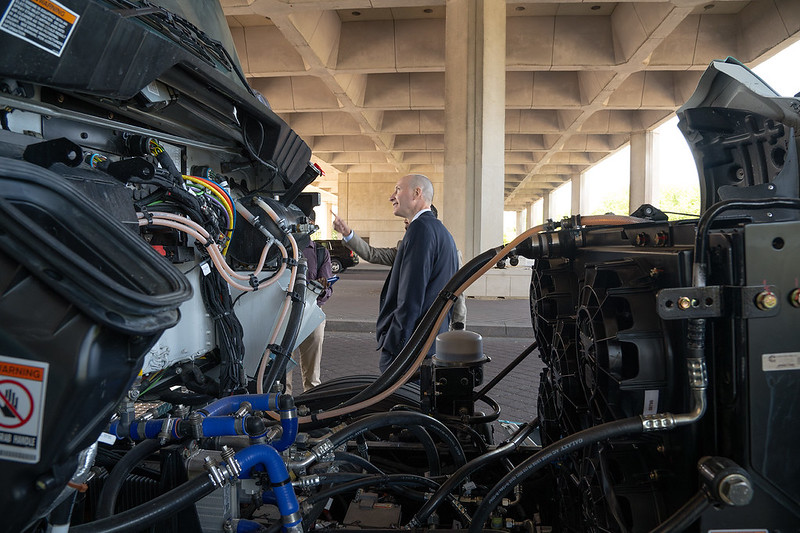By Riley Weeks, Communications Intern
Washington state has pledged to reduce greenhouse gas emissions by 95% by 2050. Federal agencies, too, are working towards net zero carbon emissions in the next several decades.
How do you even begin to tackle climate commitments this big?
One option: build hydrogen hubs, according to the Biden administration. In September of 2022, the U.S. Department of Energy’s (DOE) Office of Clean Energy Demonstrations (OCED) announced up to $7 billion in funding for the development of six to 10 hydrogen hubs across the United States. This funding came on top of the $8 billion already allocated in the 2021 Bipartisan Infrastructure Law.
Hydrogen electrolyzers use electricity to split water molecules into hydrogen and oxygen. The hydrogen can then be used as an energy carrier to power anything from trains, buses or boats to hard-to-decarbonize industries like concrete and steel. In the Pacific Northwest, a proposed hub would consist of eight different, smaller nodes. Each would produce hydrogen that would then be used to create fertilizer or power transportation at ports. If the electricity used in this water splitting process, called electrolysis, is from a renewable energy source like wind or solar, there is a potential for hydrogen hub development to aid in the green energy transition.
Green Hydrogen
Hydrogen produced using completely carbon-free energy, such as wind, solar, geothermal or hydropower. This is the most renewable form of hydrogen production, though concerns around pipeline safety, water usage, and impacts to Indigenous land remain.
Blue Hydrogen
Hydrogen produced with primary fossil fuel-generated electricity, with carbon capture techniques used for the power generation. Since carbon capture is imperfect and does not account for upstream climate pollution (like gas pipeline leaks and fossil fuel extraction), it is not necessarily renewable.
Grey Hydrogen
Hydrogen created from burning methane (“natural” gas) via steam methane reformation. Unlike blue hydrogen, greenhouse gas emissions are not captured. This is the least renewable option.
The proposed PNW hydrogen hub is slated to span across Washington, Oregon and Montana. Four of the smaller nodes will be within state lines, and one in particular, titled “node 2” by the Pacific Northwest Hydrogen Association (PNWH2), would be built at the Cherry Point refinery. Node 2 would be used for heavy-duty transportation, refining and power generation, according to the PNWH2 website.
Just the PNW Hub alone could potentially remove 1.7 million metric tons of CO2 emissions, according to the OCED.
But as with any massive undertaking to drastically reduce carbon emissions and meet clean energy transition goals, there are pros and cons to hydrogen hubs.

“[Hydrogen] comes with all kinds of costs and impacts, and the question is ‘how does that compare to fossil fuels and can it get us to a zero carbon economy faster?’” Eddy Ury, RE Sources’s Climate & Energy Policy Manager said.
Hydrogen can be a great clean energy carrier, meaning it has the ability to carry energy produced by green energy sources. Hydrogen hub development is also a great step towards a cleaner grid. The product is able to work within our current fossil fuel system as well as within a cleaner, greener grid because it can be produced through a variety of means.
Currently, the Biden administration is requiring that all proposed hydrogen hubs are powered completely through renewable energy technologies (called green hydrogen production), or that all carbon emissions from the process are recaptured (blue hydrogen). Additionally, the PNW hub is expected to create more than 10,000 jobs through its construction and operation, according to the DOE.
What are the impacts of hydrogen power?
But the project also has impacts we need to address. Hydrogen production requires massive amounts of electricity and water use, comparable to levels used by the fossil fuel industry. At the Cherry Point in particular, creating a hydrogen hub would mean a continuation of the use and occupation of the Lummi Nation’s ancestral village sites and usual and accustomed hunting and fishing grounds. Creating a hydrogen hub in the area would increase shipping and industry in the area, further harming Indigenous lifeways and aquatic ecosystems. Hydrogen production may also mean an increase in pipeline infrastructure.
The Pipeline Safety Trust, a community based nonprofit created after the 1999 Olympic Pipeline explosion in Bellingham, commissioned a report in 2022 entitled “Safety of Hydrogen Transportation by Gas Pipelines”. Hydrogen, due to its highly flammable nature, is more dangerous than the natural gas that typically flows through pipelines in our state. Even blending hydrogen into pipelines already carrying methane (natural gas) does little to curb the danger, according to the report.
PNWH2 has said that final negotiations between the Department of Energy and specific hydrogen hubs will conclude in the winter of 2024, paving the way for phase one — detailed project planning for individual hubs — to start. It will still be years before any hydrogen is actually being produced.
Until then, it is important to ensure that policy makers and communities advocate for regulations that ensure hydrogen production is done in ways that minimize the risks and harms. Decreasing our reliance on fossil fuels cannot come at the expense of human and environmental health and safety.
“We need to be vigilant about protecting what we love and want to preserve,” Ury said.
